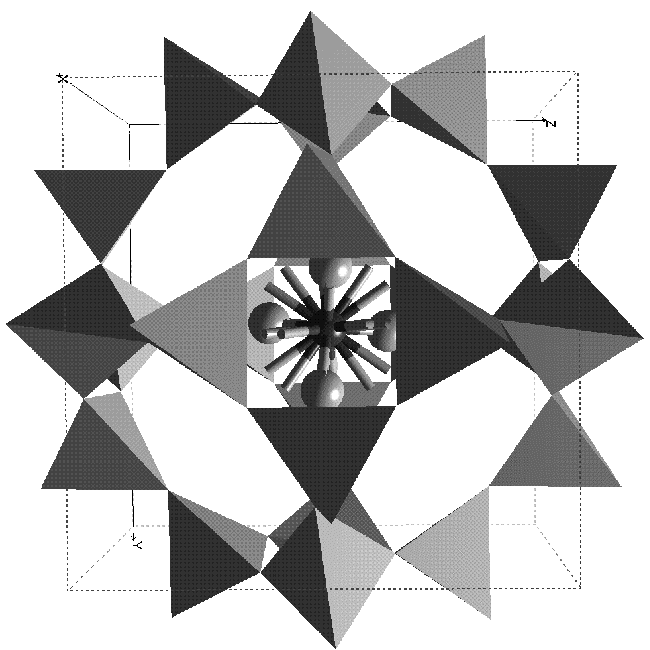
EXPERIMENTAL AND AB INITIO STUDY OF THE COMPRESSION MECHANISM OF TETRAMETHYLAMMONIUM SODALITE
Carsten Griewatsch, Wulf Depmeier, Björn Winkler
Mineralogisches Institut, Universität Kiel, D-24098 Kiel, Germany, cg@min.uni-kiel.de
Keywords Ab initio, DFT, sodalite, tetramethylammonium, high pressure
Sodalites are model systems for studies of weak interactions in guest-host compounds, as due to the flexibility of the framework weak interactions will generally lead to structural distortions. Here, we investigate guest-host interactions in tetramethylammonium sodalite, TMASOD, by density functional calculations with a plane wave basis set.
Synthetic TMASOD, N(CH3)4[AlSi5O12], crystallizes in the cubic space group I23, a=8.975A, with two formula units per unit cell [1] (Fig.1). The orientationally disordered tetramethylammonium-cation, TMA, is located in the centre of the b-cage of the well-known sodalite structure [2]. TMASOD occurs also naturally as the mineral tsaregorodtsevite [N(CH3)4][Si4(Si0.5Al0.5)2O12] [3]. However, its structure deviates from that of synthetic TMASOD, as due to aluminium/silicon ordering the symmetry is reduced to space group I222, with a=8.984(3)A, b=8.937(2)A, c=8.927(2)A.

Crystal structure of TMASOD derived from powder data [1]. One possible tetramethylammonium orientation is emphasized by a ball and stick representation. The other 20 possible carbon positions are shown by cylinders.}
An academic version of the software package CETEP (Cambridge and Edinburgh Total Energy Package) [4,5] was used for the calculations presented here. CETEP is an ab initio code for the solution of the electronic ground state of periodic systems with the wave-functions expanded in a plane wave basis using a technique based on density-functional theory [6]. Full structural relaxations in space group P1 were performed. The total number of atoms in the unit cell was 70. With fixed cubic metric various lattice constants between 8.5 A and 9.3 A were sampled. This corresponds to a maximum pressure of approximately 5 GPa. Since it is not yet possible to model a statistical distribution of atoms disordered over several sites by the ab initio calculations without using large super-cells, an ordered aluminium/silicon configuration with a maximum symmetry of the framework of I4_ had been used. Within the b-cages of the fully ordered framework, four possible ``high symmetry'' orientations of the TMA cations were used for the calculations.
One important result of the calculations is that one of these four TMA orientations is energetically more favourable than the others, with an energy barrier for the reorientation of approximately 0.1 eV. This value is in very good agreement with the activation barrier height of 0.07(2) eV derived by quasi elastic neutron scattering experiments [7]. Furthermore computed pressure induced changes in the bond lengths and bond angles of the framework were analyzed, in order to get a better understanding of the role of SiO4 and AlO4 tetrahedra during the compression of the framework.
The results of the calculations were compared with experimental data. High resolution synchrotron powder diffraction (HASYLAB, B2-diffractometer) reveal a distinct isotropic line broadening compared to the resolution function of the diffractometer. With diamond anvil cell X-ray powder diffraction up to 5 GPa the bulk modulus was determined. The large discrepancy between the experimental (24.6(7) GPa) and calculated bulk modulus (51.1(2) GPa) is consistent with the observed line broadening, as the latter is most probably caused by a partial occupation of the sodalite cages with TMA cations in synthetic TMASOD. An ideal TMASOD structure with fully occupied cages as we used for the calculations will therefore result in a much lower compressibility. The details of the TMA orientations and of the compression mechanism will be presented during the forthcoming meeting.
We would like to thank the Deutsche Forschungsgemeinschaft for financial support (De 412/13-1,2).